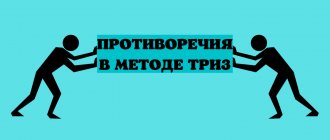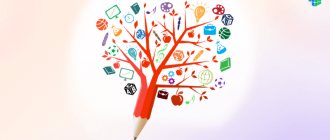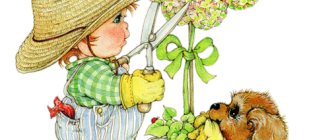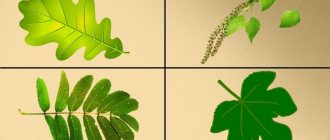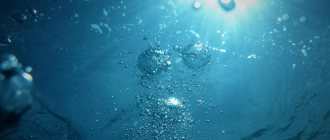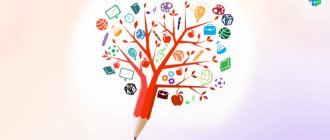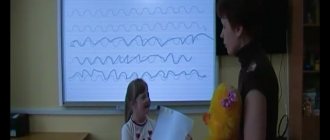TRIZ technologies in teaching drawing to children of middle preschool age
With the help of speech, the preschooler expresses his attitude towards his drawing, for example, its aesthetic assessment.
Speech gradually begins to control, plan and regulate the drawing process, helping the child to stimulate and realize the idea. The child draws what will happen, then names what is depicted in speech. To the question: “What are you drawing?” - answers: “I’ll draw it, then you’ll find out.” The appearance of the idea is due to the fact that speech moves from the end of the drawing process to its beginning and gives the preschooler the opportunity to determine in advance what he will draw. But defining the theme of the drawing is not enough for the idea to be created and realized. To implement a plan, it is necessary to highlight its content, select materials, outline the sequence of work, and evaluate the result from the point of view of how fully the plan is implemented.
The ideas of younger preschoolers are very unstable. External stimuli and difficulties that arise force the child to abandon the original goal.
The older preschooler not only states the result of drawing and formulates a plan, but also implements it. But without special training, children’s ideas, even at 5-7 years old, are often not detailed and develop as the image is created.
The implementation of a plan, in addition to the fact that it is determined by the ability to plan this process, is associated with the presence of complete ideas about the environment, as well as with the level of development of manual skill.
The implementation of a plan, independent finding of means for its implementation, a new original solution in creating an image characterize the manifestations of creativity in children's drawing.
At the same time, speech can negatively affect the originality of the drawing. Naming a figure with a certain word does not give the child the opportunity to visually analyze its outlines and encourages the repetition of a well-known graphic pattern, when a house is depicted as a connection of a square with a triangle on top.
As the child masters visual activity, an internal ideal plan of action is created, which is absent in early childhood. Therefore, it is important to note that the changes that occur in the child’s psyche during the drawing process are much more important than the drawing itself.
Drawing, reflecting the child’s knowledge and ideas about reality, at the same time helps him to master, is a means of cognition. Targeted teaching of visual arts will determine the content of children's drawings, which is determined by the gradual development of technical skills. For example, children of the third year of life draw paths and strings for balls, learning to draw straight lines. At the beginning of preschool age, the image of a person increasingly appears in drawings, which, apparently, is also associated with teaching moments. Until about 5 years of age, a child draws the same objects that adults taught him to depict. After 5 years, also with the help of an adult, children begin to overcome established patterns. Drawing for a long time, they create a huge number of drawings, reflecting everything that happens on land, in the air and at sea. The content of the drawings now includes plots from their favorite fairy tales, episodes from their own experiences, and samples seen in pictures and films. In a word, the same tendency is observed in drawing as in the development of play and writing: bizarre interweaving of the real and the fantastic. Continuation games appear, ongoing stories are invented and depicted. Favorite characters are depicted repeatedly in different situations, the child “arranges” their life, draws the events that happen to him.
Using TRIZ methods and techniques in the visual arts of preschool children
Municipal budgetary preschool educational institution
“Kindergarten of a combined type No. 11 “Olenenok”
Michurinsk, Tambov region
Compiled by the teacher
Provotorova Natalia Nikolaevna
Michurinsk-science city of the Russian Federation 2018
Visual activity is an artistic and creative activity. In the creative process, children reveal their abilities. But the use of traditional drawing methods does not allow us to fully achieve the desired result. Numerous non-traditional drawing techniques come to the rescue. Their uniqueness allows children to quickly and joyfully achieve the desired result. Children begin to believe in themselves, that they can express their ideas in a drawing, and solve a creative problem on their own. Non-traditional techniques contribute to the child’s interest, allow him to feel more relaxed and bolder. New techniques develop imagination and give freedom for self-expression. Many years of experience show that the use of non-traditional techniques increases the child’s creative potential in productive activities. But the teacher faces another huge task - to teach students to clearly express their thoughts.
TRIZ technology, adapted for preschool age, allows children to be taught under the motto “Creativity in everything.” As a result of using TRIZ technology, children’s cognitive activity increases, interest in the topic of the lesson, their horizons broaden, and an interest in novelty and imagination appears. Speech becomes figurative and logical not only in class, but also in everyday life. Such qualities of thinking as flexibility, mobility, systematicity, search activity, the desire for novelty of knowledge, speech and creative imagination develop. TRIZ methods and techniques cover many areas of educational and educational activities. They did not ignore the visual arts either. There are methods and techniques that are firmly embedded in the structure of classes and planning in fine arts, and there are those with which we can, if necessary, diversify children's activities.
The purpose of introducing TRIZ methods and techniques into children’s visual activities is to educate a creative, aesthetically developed personality capable of self-expression through various forms of artistic activity .
Main goals:
• To develop the qualities of a creative personality;
• Develop creative work skills, including the following components:
1. development of imagination,
2. originality of thinking,
3. the child’s ability to adapt to unexpected changes in the situation, the ability to reason and draw conclusions,
4. resourcefulness, attentiveness and intelligence;
TPF (typical fantasy techniques )
and RTV
(development of creative imagination)
• Revitalization. When we humanize natural objects.
For example, in a distant country there lived an evil wizard who really did not like people. One far from wonderful morning, he got tired of listening to people laughing, so he turned all the people into trees. You have the opportunity to disenchant them, but on the condition that you guess which person the wizard turned into which tree. Children look at pictures of trees and make guesses about which person and which tree was turned into. The oak tree appears to be a hero. Rowan is a fashionista because she dresses up in bright beads. The tree was called Cinderella because in life it is simple, but for the New Year it is dressed up like a princess.
The technique of getting used to the image . “If I were a creature from another planet...” Not only verbally convey the appearance and character of the character, but also depict it in a way that other children can understand.
Evil characters become good. "Baba Yaga invites you to visit." Invent and draw Koshchei the Immortal, Leshey, Vodyany and Baba Yaga as kind. Reception of entering the picture . What do you feel? How do you feel? What would you change?
Trying on an image on someone: “Mom is a fairy-tale heroine”, “Dad is a hero”, “People-animals”.
My mood. Non-objective drawing – we convey our mood with color.
Drawing emotions
Imagination games
1. “Magic pencil” (work in pairs)
Goal: to teach children to model a holistic image from chaotic signs. Develop a desire for group interaction.
Progress of the game:
Children try to draw a picture together. One of the pair draws (moves a pencil), and the second tells where to point the pencil. Rule: The pencil can only move up, down, left and right. Participants then guess the resulting images.
2. "How Animals See the World"
Goal: to teach children to shift their intellectual position in accordance with given conditions.
Progress of the game:
Children are invited to imagine themselves as some kind of animal and try to draw the world through the eyes of this animal.
3. "Creator"
Goal: to teach children to use unformed polysemantic material as elements of image construction .
Progress of the game:
Children are offered various materials (dry leaves, garbage, glitter, etc.) from which they need to make a picture and present it at an “exhibition.”
4. "Additional drawings"
Goal: to teach children to model a complete image based on a detail, part, or diagram.
Progress of the game:
Children are offered unfinished figures that they must complete.
5. "Unusual Portrait"
Goal: to teach children to model a graphic image in a constructive language.
Progress of the game:
Children are offered buttons of different colors and sizes, from which they can create any image they like.
6. Magic lines
Children find similarities between lines and objects and complete the drawing. Complication - to create a complete composition from many lines
One of the ways to develop imagination is to use non-standard drawing techniques
. It is important to teach children to experiment with various materials, teach them various imaging techniques for subsequent use in independent activities.
When organizing work on visual arts, you must follow the following rule - children should have the opportunity to choose
:
*visual material
(colored and simple pencils, watercolor, gouache, tempera, pastel, ink, charcoal, sanguine, crayons, wax candles, plasticine, clay, pebbles, shells, glue, various waste materials);
*material on which the image will be printed
: white and colored paper, velvet, patterned and plain fabric, cardboard, plywood, flat and round stones, plexiglass, PVC tiles, foil - all of different shapes and sizes.
All material must be in a place accessible to the child.
It is known that it is in free activity that a child’s personality develops more actively. Children draw with everything - with colored chalk on the asphalt, with sticks on damp sand, build figures from snow and sand and create beautiful decorations from natural materials. The children and I also come up with riddles on our walks.
In our future work, we will continue to use unconventional methods, materials and equipment.
Having done the work, I came to the conclusion that using TRIZ elements in art activities, the child not only reproduces what he sees, but also interprets and speculates his drawing in his own way. The use of TRIZ elements is the basis of developmental education; children’s feelings of constraint are relieved, shyness is overcome, and the logic of thinking gradually develops.
Seminar - workshop for teachers of preschool educational institutions "TRIZ Technology"
In preschool childhood, children love to create something new and are very proud of it. However, observing children in a group, we often notice that not all works are distinguished by independence, originality and manifestation of creative abilities.
How to develop creativity in children, how to help a child, what conditions to create for his creative growth, so that the child does not get lost, but is happy when left alone with a difficult task.
(Slide) In this work, use the “Technology for solving inventive problems”, which was created by the scientist-inventor T.S. Altshuller.
The main goal that TRIZ teachers set for themselves is: - formation of creative thinking in children, i.e. education of a creative personality prepared for stable solution of non-standard problems in various fields of activity, namely, the development in students, on the one hand, of such qualities of thinking as flexibility, mobility, systematicity, dialecticism; on the other hand, search activity, the desire for novelty; speech and creative imagination. Thus, the TRIZ methodology can be called a school of creative personality, since its motto is creativity in everything: in posing a question, in methods of solving it, in presenting material.
(Slide) The main criterion in working with children when using TRIZ is clarity and simplicity in the presentation of material and in the formulation of a seemingly complex situation. You should not force the implementation of TRIZ without children understanding the basic principles using simple examples. Fairy tales, playful, everyday situations - this is the environment through which a child will learn to apply TRIZ solutions to the problems he faces.
Often, you, teachers, are already using this technology without even knowing it.
At the moment, the theory of solving inventive problems in preschool educational institutions has a large number of specific expressions. The following methods and techniques are characterized by the greatest popularity.
- (Slide) Brainstorming is the collective generation of ideas. Brainstorming works most effectively when children are immersed in a fictitious situation where some hero, necessarily positive, supposedly needs help, advice, salvation, recommendation, etc. (let's help Alyonushka/kitten, Dunno, Little Red Riding Hood/thoughtful Prince..." ).
The basic rules of the MS are:
- exclusion of serious criticism;
- encouragement of the most extraordinary and incredible proposals;
- the ability to modernize other people's ideas;
- the presence of joint discussions, through which the group selects the most optimal ones from all the answers and allows them to solve the problem with minimal losses.
To better consolidate the experience, the results obtained during brainstorming should be put into the form of practical activity and create some kind of product reminiscent of the game: a drawing, a craft, etc.
(Slide) Synectics method (advanced brainstorming)
The concept of “synectics” means “the unification of heterogeneous elements,” and the essence of the technique itself is the search for constant analogies.
The types of connections between objects can be different:
- Personal (empathic). Here the preschooler is usually asked to imagine himself in the image of some object or phenomenon within a problem situation. Sometimes the tasks turn out to be more specific and easy (“depict a cat who didn’t like the food she bought”), sometimes more abstract and complex (“depict Chungi-Changi’s reluctance to eat only coconuts and bananas”).
- Direct. The guys find such pairs from different fields of knowledge, which are based on the same patterns. For example, a submarine looks like a fish, a helicopter looks like a dragonfly, an airplane looks like a bird, helmets and helmets look like the shells of turtles, snails and other creatures.
- Fantastic. Here the teacher and his charges create their own rules and norms that ignore existing rationality. For example, children are asked to “think about what love/joy/happiness/excitement looks like” and draw it. As a result, the analogies that are embodied on paper will turn out to be completely different: someone will draw a plant, someone will draw a person, someone will draw an animal, etc.
(Slide) Catalog method
Goal: To develop skills of analysis and synthesis, creative imagination, fantasy.
Essence of the method:
Improving objects through assigning qualities to other objects. ( car - watch (properties) - round, running, shiny; galoshes - shiny, black, waterproof, comfortable)
Grouping items (selecting items for tea utensils - highlighting the unnecessary: pot, frying pan).
(Slide) Resource method
Goal : Development of imagination, modeling skills.
Essence of the method:
Replacing the harmful effects of the energy of “fields” with an object (subject).
Types of "fields"
Mechanical; Chemical;
Acoustic; Electrical;
Thermal; Magnetic.
For example : The teacher invites children to replace (introduce) the action of any “field” to prevent an unfavorable action and obtain a favorable result.
For example: Fairy tale “The Three Little Pigs”
1.Chemical field:
“Naf-Naf took pepper-scented deodorant and sprayed it around his house. The wolf approached the house and started sneezing.....”
2.Mechanical field:
“Nuf-Nuf dug a deep ditch around his house, and planted rose hips along the edge. The wolf came...”
3.Acoustic field:
“Nif-Nif placed sound sensors around his house. The wolf came, and the sensors sounded like a fire siren.....”
(Slide) Modeling with little people (MMH)
One of the most visual embodiments of TRIZ technology in action is the method of modeling with little people. Thanks to it, preschoolers learn to imagine what objects of living and inanimate nature look like from the inside, what processes take place in them, and what the substances that fill them are. Little people can appear in the form of drawings, toys, or children themselves. This method is used when the teacher needs to explain, for example, the process of melting an icicle: in winter the tiny inhabitants are cold, and they hold hands tightly, while with the establishment of spring warmth they begin to move, turning into water. (they no longer hold hands, but lightly touch each other). Upon transition to a gaseous state, MPs begin to move, scattering in different directions. This technology develops intelligence, attentiveness, observation, and also teaches modeling and schematization.
(Slide) Method “System analysis”
It helps to consider the world in a system as a set of elements interconnected in a certain way, conveniently functioning with each other. Its goal is to determine the role and place of the functions of objects and their interaction for each sub-system and supra-system element.
For example: System “Little Frog”, Subsystem (part of the system) - paws, eyes, circulatory system, Supersystem (a more complex system that includes the system in question) - pond. The teacher asks questions: “What would happen if all the frogs disappeared?”, “What are they for?”, “What benefits do they bring?” (Children offer options for their answers and judgments). As a result, they come to the conclusion that everything in the world is organized systematically and if one link of this chain is broken, then another link (another system) will certainly be broken.
(Slide) Method of contradictions. Perception of the same object (action, phenomenon...) as opposite assessments (good - bad; dangerous - not dangerous..)
Any object (action, phenomenon...) is selected and positive and, at the same time, negative aspects are identified. For example, a book - what is good and what is bad.
(Slide) Method of fantasy: do the opposite, increase - decrease, dynamics - statics, etc. The “increase” technique. Waking up one morning, the residents of our city saw that the grass in the city had “grown to the fifth floor.” What will happen next? Who will like it and who won't? What problems will city residents face? What will be the consequences?
(Slide) Collage of fairy tales (inventing new fairy tales based on fairy tales already known to children, familiar characters in new circumstances, a fairy tale from a rhyme, rescue situations in fairy tales, fairy tales from “living” drops and blots).
Here we have looked at several TRIZ methods.
Dear Colleagues! Now I invite you to take part in a creative game, where you can show miracles of resourcefulness, ingenuity, and innovative thinking, based on consolidating the theoretical knowledge of TRIZ.
- Tasks to test the inertia of thinking. It is required to quickly answer the questions of the tasks. You can think about it, but not for long. 1. How many fingers are there on 2 hands and on 4?
- He sits in the swamp and speaks French. Who is this? (explain since when did frogs start speaking, and in French too).
- Solve a problem situation: (brainstorming)
“The grasshopper was jumping and jumping and injured his leg. How can I help him?
— How can a zoo director accurately and quickly measure a poisonous snake?
- Making wishes ( Fantasizing method)
- If I were a bird, I would...
- If I were a musical instrument, I would...
- What will happen? ( Fantasy method)
— What would happen if animals spoke with human voices?
— What will happen if the mountains turn into sugar mountains?
- What will happen if... ( Fantasy method)
— Will a person's life ever end?
— Does every person wear everything they own?
- Empathy method:
You can use words, pantomime, facial expressions.
— How does a flower feel when it is watered by rain?
— What if people walked through a clearing where a flower grows?
- Help Cinderella (brainstorming or rescue situations in fairy tales)
Cinderella kneaded the dough. When I had to roll it out, I discovered that there was no rolling pin. And the stepmother ordered to bake pies for dinner. How does Cinderella roll out the dough? Children's answers: we need to go to the neighbors and ask them; go to the store, buy a new one; maybe an empty bottle; or find a round log, wash it and roll it out; cut the dough into small pieces, and then press it with something heavy.
- Scientists have developed a new breed of hare. Outwardly, he is, in general, the same as ordinary hares, but only the new hare is black. What problem will the new hare have? How to help a new hare survive? Children's answers: (It is easier for a fox to hunt a black hare... He is especially clearly visible in the snow... Now he only needs to live underground... Or where there is no snow at all, but only black earth... And he can go for a walk now he only needs to at night... He needs to live with people so that they take care of him, protect him...)
- Rescue situations in fairy tales.
“One day the kitten decided to swim. He swam very far from the shore. Suddenly a storm began and he began to drown. . .” Offer your options for saving the kitten.
- (System analysis)
- In this task you are given a system. It is necessary to select as many words as possible included in this system. The first team was the LES system, the second team was the RIVER. (Forest - hunter, wolf, trees, bushes, path; River - bank, fish, fisherman, water, mud).
- Write an advertisement for a newspaper so that the words begin with the same letter. Example: for sale is a singing fluffy parrot, Painka, five years old, half-green. Prefers to eat cookies and drink Pepsi-Cola. Please come take a look.
Thus, today we are convinced that the use of TRIZ methods and techniques in work allows us to remove psychological barriers, eliminate the fear of the new, the unknown, and form the perception of life and educational problems not as insurmountable obstacles, but as regular tasks that need to be solved.
Thank you for your attention and participation!
